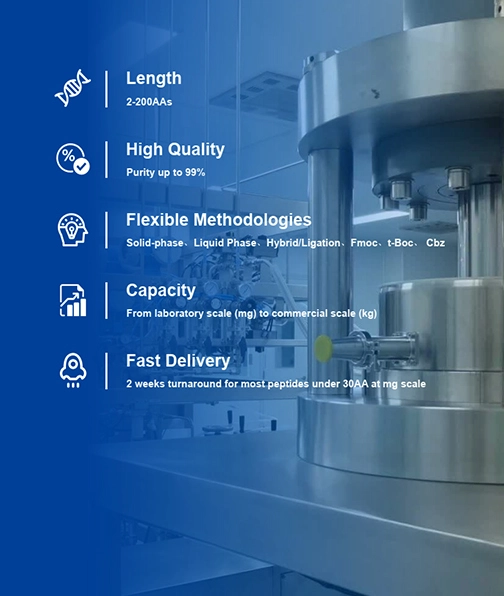As one of the top bespoke peptide manufacturers in the world, CPC is pleased to provide researchers with peptides that are constantly dependable and of the highest caliber. Thousands of ready-to-ship catalog peptides are available from CPC, but many of our orders necessitate custom synthesis. We can create peptides with lengths ranging from 2 to 200 AAs and purities ranging from 80% to 99%. We are capable of almost any peptide modification.

Each peptide, even the crude ones, comes with an analytical data package that includes a certificate of analysis, RP-HPLC (reverse-phase high-performance liquid chromatography), ESI-MS (electrospray ionization mass spectrum), and solubility test results. To help you save time and resources, we conduct solubility experiments to identify the ideal solvent conditions for solubilizing your peptide. The test can be tailored to your requirements and uses solvents that are appropriate for your experiment (water is usually the first choice). Amino Acid Analysis (AAA), peptide content, and moisture content (Karl Fisher) are additional analytical assays that are accessible upon request.

Catalog peptides are published, commercially obtainable sequences. Frequently manufactured in bulk at purity levels above 95%, commonly used catalog peptides are typically maintained on hand. Due to the bulk manufacturing method, producing these peptides in greater quantities enables businesses to sell them at reduced prices. On the other hand, custom peptide services are not in the public domain. For this reason, some alterations or adjustments to catalog peptides must be ordered as a custom order. Purity requirements and sequence length are the two main deciding factors when ordering a bespoke peptide. A bespoke peptide is typically produced at CPC over the course of two to three weeks.
Yes, CPC Scientific can aliquot any order in accordance with your requirements. This service will enable you to standardize your protocols while making it simple for you to keep and access your peptide by aliquotting your order into smaller quantities. Most importantly, by avoiding contamination from repeated container openings, the peptide will have longer-term stability. The system will definitely become moist if the container is opened and closed as well as frozen and thawed repeatedly. This could result in peptide oxidation, aggregation, and bacterial degradation, reducing the purity of your peptide and resulting in a loss of continuity in subsequent studies. Weighing will be done on our balance scale for aliquots 1 mg and up. For more accuracy than what our balance can provide, any aliquots weighing less than 1 mg will be volumetrically measured.
Unless otherwise stated, all peptides are provided by gross weight. Gross peptide weight is the sum of the weights of the peptide, peptide impurities, salts, counterions, leftover solvents, and water. While the calculation of net peptide just considers the peptide present. This can be important knowledge in some tests because the peptide content can vary greatly depending mostly on the sequence.
To get the animal to react better when creating peptide-antibodies, a carrier protein is crucial. BSA and KLH are two often utilized carrier proteins, with KLH favored due to its increased immunogenicity. Antibodies against both the peptide and the BSA will be produced when peptides and BSA are combined, which could lead to inaccurate ELISA values. We advise include a N terminal cysteine in this reaction because of its great efficiency and demonstrated efficacy in linking carrier proteins to peptides. We use MBS (maleimidobenzoic acid-N-hydroxysuccinimide ester) as a crosslinker for coupling through cysteine. The protein is first activated using MBS, and then the extra crosslinker is removed with SEC. A disulfide bond is then formed between this activated carrier protein and the cysteine in the peptide, with an efficiency of >95%. Salt formation is the only contaminant in this reaction, which we eliminate using gel filtering. We can couple the preferred carrier protein through an amino link in addition to coupling through cysteine. This reaction typically has a coupling efficiency of about 80%. Glutaraldehyde is utilized to crosslink the amino groups in the peptide and carrier protein in order to carry out this process. The possibility of protein-protein and peptide-peptide crosslinking is the reaction's most unpleasant aspect, hence ensuring the right crosslinker concentration is the most crucial step.

Please submit a detailed description of your request. We will provide you with professional services to meet your research requests. You can also send emails directly to sales@chinesepeptide.com for inquiries.